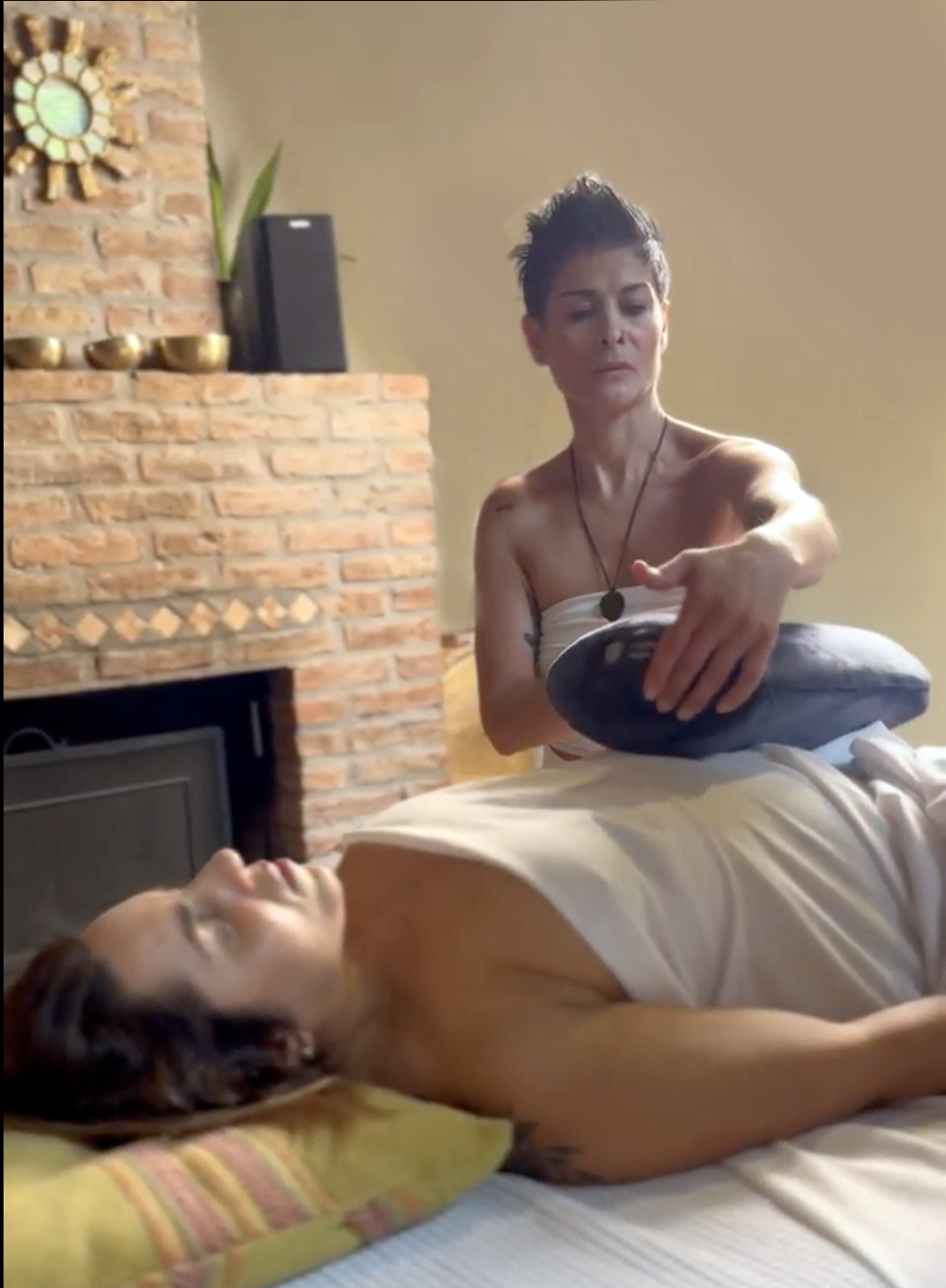Dive into the key scientific insights that have fueled the rapid adoption of Viset Technologies solutions across the world.
Introduction
Vibroacoustic therapy (VAT) has emerged as a promising therapeutic tool that combines low-frequency sound vibrations with music or specific sounds to treat various health conditions. Since its development in the 1980s in Scandinavia, vibroacoustics has been the subject of numerous studies that support its effectiveness in areas such as improving sleep, reducing pain, and decreasing anxiety. This article introduces the scientific foundations of vibroacoustics, highlighting its benefits for sleep, pain, and anxiety, and explains how these principles are applied in the Viset Pillow, an innovative device designed to make this technology accessible in everyday life.
What is Vibroacoustics?
Vibroacoustics is a form of music therapy that uses low-frequency sinusoidal sounds (between 20 and 100 Hz) and music to achieve therapeutic effects. It is defined as the application of sound vibrations and music for therapeutic purposes, offering benefits at cellular, neurological, physiological, psychological, cognitive, and spiritual levels.
Origins and Evolution
Developed in Norway in the 1980s by Professor Olav Skille, vibroacoustics has expanded globally, with renowned researchers and therapists like Dr. Lee Bartel in Canada, Tony Wigram in England, Elsa Campbell and Marko Punkanen in Finland, and Jorge Zain in Argentina. Its evolution has been driven by studies exploring its clinical applications and proving its effectiveness in various contexts.
How Does Vibroacoustic Therapy Work?
Vibroacoustics is based on the premise that sound waves generate resonance within the body. The frequencies used produce a vibratory movement in specific areas of the body, promoting stable brain oscillations essential for connectivity and cognition in the brain. Recent studies indicate that a healthy brain maintains specific levels of oscillatory activity. Dysfunctions in this activity may be linked to health issues like Alzheimer’s, Parkinson’s, chronic pain, and depression (Bartel et al., 2017). By using specific frequencies, including sound vibrations, VAT helps regulate this activity, inducing a state of calm and promoting balance in the nervous system.
Vibroacoustics and Sleep
Vibroacoustics has proven effective in treating sleep disorders, especially insomnia, which affects up to 30% of the global population. Insomnia is associated with a hyper-aroused state in the brain, making it difficult to fall asleep and stay asleep. A study conducted at Thomas Jefferson University in Philadelphia found that a one-month VAT program significantly improved sleep duration and quality in patients with insomnia. Patients experienced an average increase of 30 minutes of sleep per night and a reduction in insomnia symptoms, measured by the Insomnia Severity Index (ISI) (Zabrecky et al., 2020).
At the brain level, neuroimaging studies (fMRI) showed changes in functional connectivity in areas such as the thalamus and prefrontal cortex, which are involved in regulating sleep and alertness. These areas displayed increased functional connectivity after vibroacoustic treatment, suggesting a reduction in the hyperarousal state associated with insomnia (Zabrecky et al., 2020). In summary, VAT promotes delta wave patterns essential for deep, restorative sleep, providing a safe and non-pharmacological alternative for those suffering from insomnia.
Vibroacoustics and Pain
Vibroacoustics has also shown benefits in managing pain, especially in alleviating chronic pain and some forms of acute pain. The therapy uses frequencies like 40 Hz, which generate a deep vibration in the body, promoting tissue relaxation and reducing pain perception (Kantor et al., 2022). In cases of chronic pain, such as fibromyalgia and postoperative pain, patients receiving VAT reported a significant reduction in their pain levels, measured through tools like the Visual Analog Scale for Pain (VAS) and the McGill Pain Questionnaire.
Control studies suggest that VAT reduces the need for pain medication, especially in postoperative recovery contexts (Burke & Thomas, 1997). At the neurological level, VAT appears to impact brain areas related to pain perception and regulation, such as the somatosensory cortex and the limbic system, which may explain its effectiveness in alleviating pain at both physical and emotional levels. This makes VAT a non-invasive and complementary solution to conventional treatments (Kantor et al., 2022).
Vibroacoustics and Anxiety
Anxiety is another area where vibroacoustics has shown positive results. Chronic stress and anxiety are associated with constant activation of the sympathetic nervous system, which can lead to long-term health issues. Vibroacoustics, by inducing a deep relaxation state, can activate the parasympathetic nervous system, helping to reduce stress and anxiety (Boyd-Brewer & McCaffrey, 2004).
Studies have shown that VAT helps reduce cortisol levels, the body’s primary stress hormone, and promotes the release of endorphins, creating a sense of well-being. Furthermore, by improving sleep and reducing pain, VAT indirectly contributes to a reduction in anxiety symptoms. The combination of vibration and sound facilitates a sensory experience that allows people to reach a state of calm, lowering heart rate and relaxing muscles (Hollins et al., 2014).
Why Choose the Viset Pillow?
The Viset Pillow is an innovative device that integrates the science of vibroacoustics into an accessible format for daily users. Designed by music therapy experts in Argentina, this device was developed with an ergonomic design to maximize the therapeutic benefits of sound vibration. Unlike other tools on the market, the Viset Pillow offers a wide range of Sound Vibration programs, selected to induce deep relaxation and help with sleep, pain, and anxiety management. All these programs are available in the Viset App, which also includes a catalog of original music specially composed by music therapists and sound healers to accompany the immersive Sound Vibration experience.
Thanks to its portable and user-friendly design, the Viset Pillow allows users to experience the benefits of VAT anytime during the day, whether before sleeping or during restorative breaks.
How to Use Sound Vibration Safely
To fully harness the benefits of Sound Vibration, it is essential to use your Viset Pillow appropriately. Here are some tips to help you get the most out of it:
- Session Duration: We recommend sessions of 20 to 45 minutes.
- Frequency of Use: You can perform between 1 and 3 sessions daily. In cases of insomnia, during the night, you may perform one or two sessions. We do not recommend using it throughout the night to avoid overstimulation and losing the sedative effect of Sound Vibration. For pain, one daily session can be beneficial.
- Avoid Maximum Volume: Moderate vibration levels are more effective and safe for achieving the desired benefits.
- Precautions: Avoid using it on sensitive areas like the skull, and stop use if you experience pain or discomfort. Additionally, consult a healthcare professional before use if you have specific medical conditions.
The Viset Pillow is designed with user safety and well-being in mind, providing a balance between power and softness in its vibrations. This device is an ideal tool for those seeking a non-invasive, natural solution to improve their health and wellness.
Conclusion
Vibroacoustic therapy is emerging as an effective and safe therapeutic tool for improving sleep, reducing pain, and managing anxiety. Although research continues, current studies support the effectiveness of VAT as a non-invasive, side-effect-free method for treating various conditions. For those seeking alternatives to traditional pharmacological treatments, VAT offers a natural, scientifically-backed option with potential benefits that span both physical and mental well-being.
Bibliographic References
- Bartel, L. R., Chen, R., Alain, C., et al. (2017). Vibroacoustic stimulation and brain oscillation: from basic research to clinical application. Music and Medicine, 9(3), 153-166.
- Boyd-Brewer, C., & McCaffrey, R. (2004). Vibroacoustic sound therapy improves pain management and more. Holistic Nursing Practice, 18(2), 111-118.
- Burke, M., & Thomas, K. (1997). Use of physioacoustic therapy to reduce pain during physical therapy for total knee replacement patients over age 55. In T. Wigram & C. Dileo (Eds.), Music Vibration and Health (pp. 99–106). Jeffrey Books.
- Hollins, M., McDermott, K., & Harper, D. (2014). How does vibration reduce pain? Perception, 43(1), 70-84.
- Kantor, J., Campbell, E. A., Kantorová, L., et al. (2022). Exploring vibroacoustic therapy in adults experiencing pain: A scoping review. BMJ Open, 12(1), e046591.
- Zabrecky, G., Shahrampour, S., Whitely, C., et al. (2020). An fMRI study of the effects of vibroacoustic stimulation on functional connectivity in patients with insomnia. Sleep Disorders.





Share:
Why You Should Embark on a Sound Vibration Journey